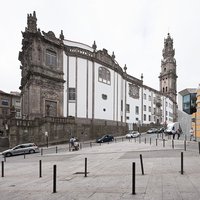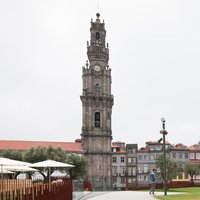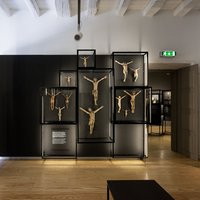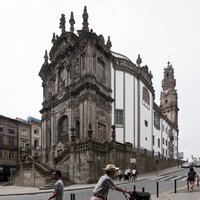
Torre, Museu, Igreja
O conjunto arquitetónico Clérigos, classificado Monumento Nacional desde 1910, é pela sua Igreja e pela sua Torre, um dos principais pontos de interesse, e local de visita obrigatória para todos os que visitam a cidade do Porto.
A Igreja e a Torre integram uma edificação do século XVIII, de inspiração barroca, que marcou a configuração urbana da cidade, localizada numa rua desnivelada, mas genialmente aproveitada por Nicolau Nasoni, que conseguiu criar um edifício de referência. A Igreja e a Torre estão unidas pela Casa da Irmandade, que desde 2014, após a sua musealização, está aberta ao público.

Torre
No ano de 1753, a pedido da Irmandade dos Clérigos, o arquiteto italiano Nicolau Nasoni apresentou o projeto para uma torre sineira, e em 1754 arrancariam as obras daquela que viria a ser a mais bela e altaneira Torre, dominando toda a paisagem urbana do Porto. Em julho de 1763, com a colocação da cruz de ferro no topo, e a imagem de São Paulo no nicho sobre a porta, deu-se por finalizada a sua construção.
As características barrocas que a definem são a expressão máxima da espetacularidade do barroco, onde os motivos típicos deste estilo, dão à torre movimento e beleza.
A mais de 75m de altura, depois de subir 225 degraus e chegar ao topo da torre, a vista sobre a cidade deslumbra. Numa perspetiva a 360°, o visitante usufrui de um momento único, quer de dia ou de noite, quando em épocas especiais, a torre abre as suas portas até às 23h00.
A Torre dos Clérigos, é incontestavelmente o ex-líbris da cidade, e um excelente miradouro sobre esta.

Museu
O percurso pela Casa da Irmandade (1754-1758), onde se localiza o Museu propicia um regresso ao passado, a experiência de percorrer espaços, que em tempos, foram privados e destinados ao quotidiano da Irmandade dos Clérigos.
Percorrendo a Casa do Despacho, a Sala do Cofre, o Cartório, e a antiga enfermaria, percebe-se que o Museu possui um acervo constituído por bens culturais de valor artístico considerável, do século XIII até ao século XX, que se espraia nas coleções de escultura, pintura, mobiliário e ourivesaria. Esses bens são mensageiros de um património histórico e cultual, cuja função perdida na passagem do tempo, deu lugar à sua musealização.
A enfermaria da Irmandade dos Clérigos que funcionou até finais do século XIX dedicada ao tratamento dos clérigos doentes, foi convertida num espaço expositivo, e acolhe atualmente a coleção Christus. Esta exposição, concebida a partir da doação de uma coleção por parte de um colecionador particular, desvela a paixão pelo colecionismo, e conta uma história complementada com objetos, outrora de devoção, considerados hoje legados culturais de interesse. São peças de escultura de vulto, pintura e ourivesaria que enaltecem o encontro da arte com a fé.
A exposição, distribuída por três salas – Núcleo da Paixão, Viagem das Formas e Imagens de Cristo – convida a uma viagem pelo tempo e pelo espaço, pela imagem e pela devoção.
O Museu da Irmandade dos Clérigos, integra a Rede Portuguesa de Museus, desde 28 de agosto de 2018.

Igreja
A doação de um terreno, localizado no Campo do Olival, à época o maior terreiro portuense, permitiu à Irmandade dos Clérigos construir igreja própria.
O projeto da Igreja dos Clérigos, de autoria de Nicolau Nasoni, foi aprovado na reunião da Irmandade dos Clérigos, em dezembro de 1731. As obras arrancaram em abril de 1732, com a abertura dos alicerces, iniciando-se assim a construção daquela que viria a ser a primeira igreja em Portugal com planta oval. E não só. A galeria que circunda toda a nave, possibilitando observar a igreja no seu todo, é também uma característica singular deste templo. As várias janelas existentes permitem a entrada de luz, que realça o esplendor da talha dourada, presente na igreja, criando um belo jogo de cores com o mármore.
A cúpula ostenta o brasão de armas da Irmandade dos Clérigos, em granito fingido, e assenta sobre seis pilastras, destacando-se dois púlpitos e duas grades, os exemplares mais antigos de talha dourada na igreja, e se abrem quatro altares laterais: o do Santíssimo Sacramento, Nossa Senhora das Dores, Santo André Avelino e São Bento.
Dezassete anos depois, em 1749, a edificação da igreja era dada como concluída, mas o seu apetrechamento, e mais tarde, a ampliação da capela prolongariam por mais uns anos as obras na igreja.
Ao fundo, a espaçosa capela-mor de forma retangular oblonga (mais comprida que larga), é embelezada com um altar de mármore e um retábulo de inspiração rococó, com risco de Manuel dos Santos Porto, no qual predomina um trono coroado pela imagem da padroeira, Nossa Senhora da Assunção. Nos flancos do retábulo, destacam-se os co-padroeiros da Irmandade dos Clérigos, São Pedro ad Vincula e S. Filipe Néri, duas esculturas de madeira pintadas.
A capela-mor é ladeada pelo cadeiral e pelos dois órgãos de tubos ibéricos ou "à portuguesa", cuja construção iniciou em simultâneo, decorria o ano de 1774. O cadeiral terminaria em 1777 e os órgãos apenas dois anos depois.